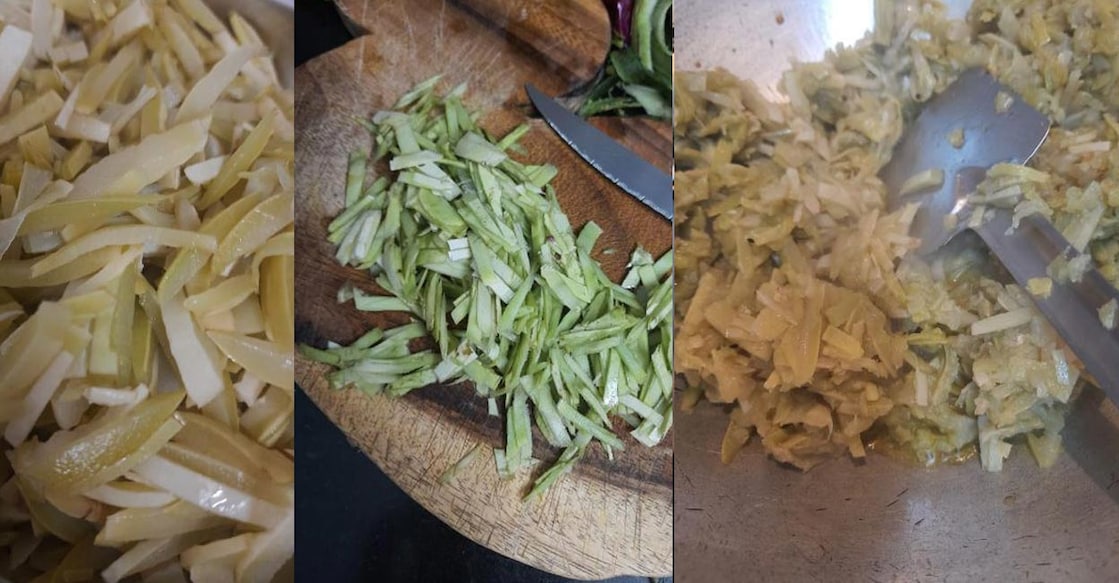Some food that is best served with a twist: Bengali food stories with hint of Awadh

Mail This Article
It is 7 in the morning. Swapan, my cook, has entered the kitchen after his routine bath and cleaning the kitchen floor to sit on the floor. He is chopping fruits for our breakfast. Sitting comfortably on the floor with the Bo(n)ti (spelt nasally in Bengali) aka hasua (in Hindi) one foot resting on the wooden footrest of the sharp iron cutter. He is slicing a watermelon with this metal chopper which can be seen in most Bengali homes.
I hand him a thaal (metal plate).
“Give me the peels,” I say.
He looks at me quizzically, as if saying, “Again one of your quirks!” The peels will be collected, but not for the composting pit this time.
After the fruits Swapan will chop the vegetables. Today, there is lauki (long gourd). He knows the skin needs to be cooked too, so the peel will be kept aside and chopped into fine slivers.
I sit on the low kitchen stool, with the watermelon peels on the thaal and a knife. Start scooping out the inner white part of the watermelon skin. This is also our sharing time. We sit and talk sharing our stories. I tell him about my grandmother, whom we called Bouma for some reason. That is another story for another day. But today, some kitchen tips from my grandmother to my cook. This way, I get to reshare my own understanding about the food learnings that I have been handed down.
Bouma was a frail woman, probably robust when young. But I have memories of her when she was of 70 years or so. I was a smidgeon of a child then. A woman who had experienced the vagaries of being a young widow with a two-year-old son, my father, and an eight-year-old daughter, my aunt. A woman who had to flee the riots of Partition following the terrible Bengal Famine. Her body and mind had borne it all. The wife of a doctor who had worked in the British owned collieries of undivided Bengal, she had seen the best as well as the worst of it all. So, who better to tell us about saving food than Bouma!
She would sit in front of the pujor ghor (puja room) in the morning, helping Ma with the kitchen chores. I remember sitting and watching her. The red cement floor had been cleaned. Bo(n)ti placed. All vegetables sat next to her in a wicker basket. Water in a brass tumbler to dip the potatoes. All arranged properly by Ma – after which chopping, peeling and cutting would start.

In her traditional white saree, Bouma would be sitting with one of her feet on the base of the bo(n)ti on the floor. To keep balance and sit comfortably, the other leg would be neatly folded under her. Deft fingers moved swiftly. As per the dishes being cooked, the vegetables would be peeled and chopped precisely.
Peels would never be thrown. They too would be sliced and kept in a pile, ready to be cooked into a che(n)ki -- a stir fry. She would look at me and say, “Never waste food. Never. A farmer grows food facing vagaries of nature. These peels are nutritious and, most importantly, the roughage is good for your gut.”
Swapan adds, “Those bo(n)tis were deadly. Not this one that I use. They could chop the head off a rohu as well as peel the long gourd. Now tell me what plans you have for the watermelon peels.”
“Chutney… Here, take this raw mango. Peel and slice, just like you did with the watermelon. Don’t throw away the peels. Today is peel day. Okay!”
Swapan smiles, “Your customers will like this for sure.”
I smile back.
With Swapan’s help, I run a small home kitchen, Luchee Food Story, curating seasonal food. Prior to the lockdown, I was organising home food ‘pop-ups’, telling stories of the food and it’s connect with festivals and farming. With lockdown, I have started to send out food parcels.
How to cook lauki (bottle gourd) skin/peel
Total time from cutting to eating, 20 minutes max
Chop and boil the peeled skin of the lauki with enough water that will get absorbed and soften the skins. Warm a teaspoon of mustard oil in a small kadhai (wok), add Kalonji (nigella) seeds and green chillies to taste. Add the peels and stir. Cover. Cook for 5 minutes. When done, add some couscous or posta seeds and stir well. Your lauki peel dish is done.
Tarbooz (watermelon) peel hip hop
Total time from cutting to eating, another 15 minutes max for each dish
Chutney
Cut slivers of the white inside part of watermelon peel. Cut a raw mango and slice off the peel into small pieces. In hot mustard oil, add mustard seeds or panch phoron (a mix of five spices). Let it crackle. Add the chopped watermelon peels and the sliced raw mango pieces with the peels. Add salt as per taste. Add water. Cover and boil till it gets cooked. Add sugar or any other sweetener as per taste. Let it dry. Your chutney is done.

Bata (grind or paste)
Take some peels of a watermelon. Chop. Put them in your mixie. Add 2-3 green chillies. Add raw garlic (4-5 pieces) and coriander leaves as per taste. Stir.

Heat a wok that has been used. Stir the mix in low flame till it gets dry. If you like it spicy, then give it a tadka (crackle) of mustard oil and green chillies. Dry it.
You can reach Sharmila Sinha at 9818482018
(The author runs a small home kitchen, Luchee Food Story)

